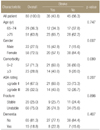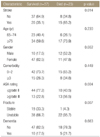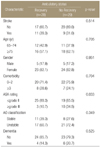Abstract
Purpose
The purpose of this study was to compare the general characteristics that affect the prognosis and evaluate the influence of stroke on one-year postoperative mortality and recovery of ambulatory status in elderly patients over 65 years old with femoral intertrochanteric fracture.
Materials and Methods
This study included 80 patients who were followed-up for one year after proximal femoral nailing for femur intertrochanteric fracture between January 2008 and December 2013. We analyzed the relationship among the one-year postoperative mortality, recovery of ambulatory status and the associated factors (age, gender, associated underlying disease, American Society of Anesthesiologists [ASA] grade, comminution of the fracture, dementia).
Results
The one-year postoperative mortality rate in all patients and patients with stroke was 28.8% and 42.9%, respectively. The one-year postoperative mortality rate was significantly higher in patients with stroke, high ASA grade, and unstable fracture. Decrease of the one-year postoperative ambulatory status was 50.9% in all patients and was significantly associated with grade III or IV ASA rating. No significant relationships were observed between the one-year postoperative recovery of ambulatory status and stroke.
Figures and Tables
Table 1
Analysis of Ambulatory Status by Koval*

*Categories of Walking Ability by Koval. 1) Community ambulator: independent community ambulator, community ambulator with cane, community ambulator with walker/crutches. 2) Household ambulator: independent household ambulator, household ambulator with cane, household ambulator with walker/crutches. 3) Nonfunctional ambulator.
Table 5
Logistic Regression Analysis of Various Characteristics on One-Year Mortality (Final Model by Backward Elimination Method)

References
1. Kenzora JE, McCarthy RE, Lowell JD, Sledge CB. Hip fracture mortality. Relation to age, treatment, preoperative illness, time of surgery, and complications. Clin Orthop Relat Res. 1984; 186:45–56.
2. Zuckerman JD, Skovron ML, Koval KJ, Aharonoff G, Frankel VH. Postoperative complications and mortality associated with operative delay in older patients who have a fracture of the hip. J Bone Joint Surg Am. 1995; 77:1551–1556.

3. Chang JD, Kang ST, Lee EJ, Choi SJ, Chang HG, Lee CJ. A study of the factors which influence on the one-year mortality rate after hemiarthroplasty in older patients with hip fracture. J Korean Hip Soc. 1998; 10:225–232.
4. Choi JC, Na HY, Lee YS, et al. Mortality after treatment of hip fracture over 80 years old. J Korean Hip Soc. 2006; 18:116–120.
5. Kim SK, Hong JS, Park JH, Park JW, Kim JH. Mortality and functional recovery after bipolar hemiarthroplasty of femoral neck fractures in elderly patients. J Korean Hip Soc. 2002; 14:49–57.
6. Poplingher AR, Pillar T. Hip fracture in stroke patients. Epidemiology and rehabilitation. Acta Orthop Scand. 1985; 56:226–227.
8. Elliott J, Beringer T, Kee F, Marsh D, Willis C, Stevenson M. Predicting survival after treatment for fracture of the proximal femur and the effect of delays to surgery. J Clin Epidemiol. 2003; 56:788–795.

9. Schrøder HM, Erlandsen M. Age and sex as determinants of mortality after hip fracture: 3,895 patients followed for 2.5-18.5 years. J Orthop Trauma. 1993; 7:525–531.
10. Endo Y, Aharonoff GB, Zuckerman JD, Egol KA, Koval KJ. Gender differences in patients with hip fracture: a greater risk of morbidity and mortality in men. J Orthop Trauma. 2005; 19:29–35.

11. Gdalevich M, Cohen D, Yosef D, Tauber C. Morbidity and mortality after hip fracture: the impact of operative delay. Arch Orthop Trauma Surg. 2004; 124:334–340.
12. Ishida Y, Kawai S, Taguchi T. Factors affecting ambulatory status and survival of patients 90 years and older with hip fractures. Clin Orthop Relat Res. 2005; 436:208–215.

13. Cornwall R, Gilbert MS, Koval KJ, Strauss E, Siu AL. Functional outcomes and mortality vary among different types of hip fractures: a function of patient characteristics. Clin Orthop Relat Res. 2004; 425:64–71.
14. Davis FM, Woolner DF, Frampton C, et al. Prospective, multi-centre trial of mortality following general or spinal anaesthesia for hip fracture surgery in the elderly. Br J Anaesth. 1987; 59:1080–1088.

15. Clague JE, Craddock E, Andrew G, Horan MA, Pendleton N. Predictors of outcome following hip fracture. Admission time predicts length of stay and in-hospital mortality. Injury. 2002; 33:1–6.

16. Koval KJ, Skovron ML, Aharonoff GB, Meadows SE, Zuckerman JD. Ambulatory ability after hip fracture. A prospective study in geriatric patients. Clin Orthop Relat Res. 1995; 310:150–159.
17. Shah MR, Aharonoff GB, Wolinsky P, Zuckerman JD, Koval KJ. Outcome after hip fracture in individuals ninety years of age and older. J Orthop Trauma. 2001; 15:34–39.

18. Hooper G. Internal fixation of fractures of the neck of the femur in hemiplegic patients. Injury. 1979; 10:281–284.

19. Miller CW. Survival and ambulation following hip fracture. J Bone Joint Surg Am. 1978; 60:930–934.

20. White BL, Fisher WD, Laurin CA. Rate of mortality for elderly patients after fracture of the hip in the 1980's. J Bone Joint Surg Am. 1987; 69:1335–1340.
21. Kho DH, Kim KH, Shin JY, Lee JH, Kim DH. Postoperative mortality rate of hip fracture in elderly patients. J Korean Fract Soc. 2006; 19:117–121.

22. Kim DS, Shon HC, Kim YM, Choi ES, Park KJ, Im SH. Postoperative mortality and the associated factors for senile hip fracture patients. J Korean Orthop Assoc. 2008; 43:488–494.

23. Suh YS, Kim YB, Choi HS, Yoon HK, Seo GW, Lee BI. Postoperative mortality and the associated factors in elderly patients with hip fracture. J Korean Orthop Assoc. 2012; 47:445–451.

24. Chang JD, Yoo JH, Lee SS, Kim TY, Jung KH, Kim YK. Bipolar hemiarthroplasty for hip fractures in patients aged over 90 years: the factors influencing the postoperative mortality. J Korean Hip Soc. 2010; 22:283–290.
25. Owens WD, Felts JA, Spitznagel EL Jr. ASA physical status classifications: a study of consistency of ratings. Anesthesiology. 1978; 49:239–243.
26. Lyons AR. Clinical outcomes and treatment of hip fractures. Am J Med. 1997; 103:51S–63S. discussion 63S-4S.

27. Feng M, Zhang J, Shen H, Hu H, Cao L. Predictors of prognosis for elderly patients with poststroke hemiplegia experiencing hip fractures. Clin Orthop Relat Res. 2009; 467:2970–2978.





 PDF
PDF ePub
ePub Citation
Citation Print
Print







 XML Download
XML Download